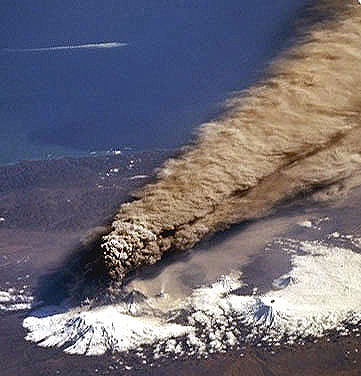[/caption]
Think about a classic volcanic eruption, with a huge cloud of volcanic ash rising up from a giant cinder cone. That’s a Plinian eruption, named after the Roman statesman Pliny the Younger, who witnessed the eruption of Italy’s Mount Vesuvius in 79 AD. As you probably know, that eruption desctroyed the downs of Pompeii and Herculaneum, killing thousands of people.
Plinian eruptions are associated with volatile-rich dacitic to rhyolitic lava, and they typically erupt from stratovolcanoes (think Mt. Fuji). A Plinian eruption can go on for hours or days, sustaining a giant eruptive column. The thrust of the expanding gases give the volcanic material an exit velocity of several hundred meters per second. Some of these eruptive columns can reach heights of 45 km.
What goes up has to come back down. The material thrown so high in a Plinian eruption rains back down over a large area, covering everything in a thick covering of ash. Cubic kilometers of ash can come down on the surrounding landscape.
Plinian eruptions can also generate one of the most dangerous events associated with volcanic eruptions: pyroclastic flows. This is where an eruptive column can collapse. Instead of flowing up high into the air, the hot gas, rock and ash coming from the volcano flows down its steep sides, reaching speeds of 700 km/hour. Everything in the path of the flow is destroyed by this high speed, superheated gas and rock. Pyroclastic flows have been known to travel hundreds of kilometers from an eruption site.
We have written many articles about the Earth for Universe Today. Here’s an article about different types of volcanoes, and here’s an article about different types of lava.
Want more resources on the Earth? Here’s a link to NASA’s Human Spaceflight page, and here’s NASA’s Visible Earth.
We have also recorded an episode of Astronomy Cast about Earth, as part of our tour through the Solar System – Episode 51: Earth.

